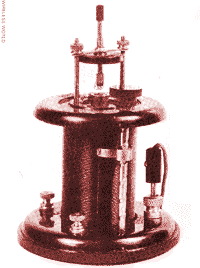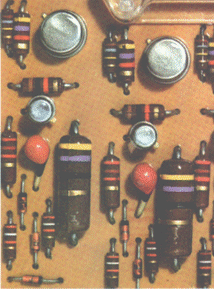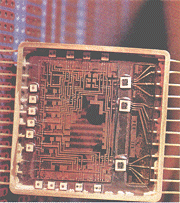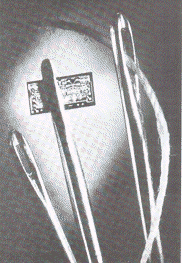
 |
How it works : Electronics |
Electronics is the branch of science and engineering concerned with the understanding, development and applications of electronic devices. On the theoretical level it involves a large number of scientific disciplines including PHYSICS, CHEMISTRY, THERMODYNAMICS, QUANTUM mechanics and MATHEMATICS.
As an applied science it has grown out of electrical engineer ing which is concerned with every aspect of ELECTRICITY: its generation, control, distribution, storage and applications. Today, the electronics industry is an integral part of modern industrial life and is becoming more and more important in the underdeveloped parts of the world as well. For example, today there are more than 800 million TRANSISTOR radio sets in use throughout the world.
Electronic devices
An electrical CIRCUIT is designed to control
electric current for a particular purpose and consists of components, or
elements, with specific electrical characteristics. The most common components
found in electrical circuits are
RESISTORS, CAPACITORS, INDUCTORS, SWITCHES and POTENTIOMETERS and they can be used separately or together in a variety of ways. Electronic circuits are a development from electrical circuits and include electronic devices, such as thermionic VALVES [vacuum tubes], gas filled tubes and SEMICONDUCTORS.
Thermionic valves and related devices
With the advent of the thermionic valve [vacuum tube] and other related
devices, the scope of applications was further increased and new potentials
realized. Vacuum tube devices are a particular 'family' of electronic devices
and consist basically of two electrodes sealed within an evacuated glass
tube. One electrode, called the cathode, is constructed from an alkali
metal such as caesium which readily 'boils off' electrons when heated. The
other electrode, called the anode, is usually maintained at a positive
voltage with respect to the cathode so that these electrons are drawn away
and accelerated towards the anode. In this way a current flows through the
device.
 |
Above: early crystal receiver set. It consists of an induction coil with slide contact and a cat's whisker diode demodulator mounted on top. With the slide contact, the circuit could be tuned to a station. |
This particular vacuum tube is called a DIODE because it contains only two electrodes. These have the property that an electron current can Only flow in one direction as no electrons are available at the anode for current to flow in the other direction, so the diode is used to rectify alternating (AC) currents.
A triode valve is a diode with an extra (third) electrode placed between the anode and cathode. This third electrode is in the form of a mesh or grid which allows electrons to pass through relatively unhindered. When, however, a voltage is applied to this grid the electron current flowing through the device is modified or controlled- hence the term 'valve'. Small changes in grid voltage can produce large charges in cathode-anode current.
In some applications two or more grids are required, which can independently control the electron current. Such thermionic valves are called tetrodes (2 grids), pentodes (3 grids) and so on.
The CATHODE RAY TUBE (CRT) is a vacuum tube device designed to produce a visual display. Again, electrons are boiled off a hot cathode and drawn towards the (positive) anode, but in the centre of this is a hole through which some of the electrons can pass in the form of a beam. At the front of the CRT is a fluorescent screen which glows when bombarded with electrons. Using a grid between anode and cathode to control the intensity of the beam, a focusing system to focus the beam to a point at the screen, and deflection plates to move the spot on the screen around, a useful display can be created.
The Klystron, magnetron and travelling-wave tube are other types of thermionic vacuum tube devices for the amplification of very high frequency signals to high output powers (see MICROWAVE DEVICES).
Gas filled tubes
The most common application of gas filled devices is in light
displays such as DISCHARGE TUBES, fluorescent lights, neon lamps and so on.
These are, however, not generally described as electronic devices because
they do nothing more than provide light. There is no clear distinction here,
as, for example, the particular characteristics of a gas discharge makes
it useful in overload voltage protection equipment. When a certain critical
voltage is reached (the striking voltage) a discharge is formed and
it acts as a low impedance 'short-circuit', protecting any surrounding components
(electronic or otherwise). Also, at a certain magnitude of discharge current
these devices exhibit a negative resistance. That is, as the current is increased
the voltage between the electrodes drops. This voltage-current characteristic
is opposite to a resistor. Such devices can be used in OSCILLATOR circuits.
Gas filled diodes work on a similar principle to vacuum tube diodes insofar as the cathode is designed to emit electrons. In gas filled diodes, however, current is conducted through the gas rather than as a beam of electrons. Also, electrons can be knocked out of the cathode by bombardment with positive gas IONS (atoms which have lost an electron).
The mercury arc rectifier (diode) is another similar device.
 |
| Above: this is an electronic circuit composed of discrete components including transistors (silver), diodes (small pink), capacitors (bulbous red), and resistors (brown body) mounted on a board. |
Conduction takes place in a pure mercury vapour produced by a spark heating device adjacent to a reservoir of mercury which also forms the cathode. A carbon electrode is- commonly used for the anode. Such devices are used where large AC currents need to be rectified.
Other gas filled devices include the thyratron-a type of triggered diode with three terminals rather like a triode valve- and stepping, or counter, tube devices such as the Dekatron. Here, a glow discharge between a cathode and an anode can be made to travel around a numbered tube and so produce a numerical display (see COUNTING DEVICES).
Semiconductor devices
By far the most important area today is semiconductor electronics. But
although the semiconductor transistor is a relatively modern invention,
semiconducting materials (that is, materials which do not properly conduct
but which cannot be classified as insulators) have been known since the beginning
of this century.
The 'cat's whisker' diode was an early invention consisting of a fine wire contact on the surface of a semiconductor crystal such as carborundum or silicon. It is the junction between the wire and the crystal which produces the diode action.
Copper oxide, selenium and tantalum rectifiers (known as metal rectifiers) can also be classified as semiconducting devices.
Silicon and germanium semiconductors are the most common electronic devices available today. As pure materials, silicon and germanium make poor conductors (except at elevated temperatures) but when a small amount of impurity is added-called a 'donor'-the conducting characteristics change completely.
In its simplest form, the germanium or silicon diode consists of a thin slice of the basic material alloyed on one surface with a donor material (antimony in the case of germanium) to produce an n-type semiconductor. This is a material with sufficient electrons in the conduction band (or shell) surrounding each atom nucleus for electron conduction to occur through the material. The other surface is alloyed with another material (for example, indium in the case of germanium) creating a p-type semiconductor. This has a deficiency of electrons in the conduction band which can be considered as 'holes' or vacancies for electrons and as such are positive. These positive 'holes' can move easily through the material under the influence of an electric field as can electrons in an n-type material.
Between the n-type and p-type sections is 'the junction'-a region where neither holes nor electrons can easily move- which acts as a barrier to the flow of current. When the device has a voltage applied across it in one direction, the barrier is reduced and current flows. With the voltage reversed, the barrier is increased and no current flows-this is the diode action.
The transistor consists of a p-n-p or n-p-n sandwich with three leads, one to each section. The lead to the middle section (known as the base-equivalent to the valve grid) can be used to control the flow of current between the two outer sections (known as the collector and emitter-equivalent to the anode and cathode of a valve). As such, transistors act rather like triode valves and are useful in a multitude of situations including amplifier (analog) and switching (digital) circuits.
The thyristor consists of a p-n-p-n sandwich with three external connections-anode, cathode and gate. -This device behaves like a conventional p-n junction diode when it is 'triggered' by a current pulse via the gate terminal connected to the inner p-type section. Thyristors are sometimes called silicon controlled rectifiers (SCR), behaving in a similar manner to thyratrons, and are particularly useful in power control systems such as ELECTRIC MOTOR control circuits.
All these devices are available in a variety of shapes and sizes for specific applications and through research and development are constantly being modified and improved.
| Right: a hybrid circuit before encapsulation. This consists of several integrated circuits interconnected in a more complex unit. |  |
 |
Left: the smallness of the silicon chip, on which extremely
complex circuits are made, is illustrated here. The circuit is a TTL
(transistor-transistor logic) type for
counting pulses
in decimal. It will pass through the eye of a No 5 sewing needle. |
History of electronics
The study of electricity and electromagnetism flourished with the discovery
of a continuous source of electric current-the BATTERY. This occurred in
1800 when Alessandro VOLTA invented the 'voltaic pile'. For the next half
century various electrical and electromagnetic devices were developed-one
important invention being the TELEPHONE pioneered by A G BELL in the 1870s.
The development of electronic equipment was significantly concentrated on communications systems where some means was required for amplifying weak telegraph and telephone signals, and the triode valve proved to be the answer. Lee de Forest announced this discovery in 1906, two years after Sir John Ambrose FLEMING had developed the diode. It was not until 1911, however, that the triode was considered as a useful current amplifier. In 1912, feedback circuits were employed in AMPLIFIERS and in 1913 feedback was used in an oscillator circuit.
As early as 1887, Heinrich HERTZ had demonstrated the physical existence of electromagnetic waves and in 1895 Guglielmo MARCONI demonstrated a primitive form of RADIO communication (radio telegraphy). For the transmission of speech, however, a source of high frequency AC voltage is required, which stretched electromechanical systems to their limit. In 1900 a high frequency ALTERNATOR was used in transmitters which sent speech signals a distance of 25 miles. With the introduction of the triode valve driven oscillator, however, the operating frequencies and transmission distances were increased and in 1916 speech signals were transmitted on medium and short wave frequencies. Regular BROADCASTING followed in 1920, with successful short wave radio transmissions over long distances demonstrated in 1922.
The old 'crystal set' receivers employing the 'cat's whisker' diode flourished during this period, but the cat's whisker device was invented back in 1901. Valve operated radio receivers became a practical proposition after the development of the high vacuum or 'hard' thermionic valve in 1914-15. This improved the characteristics and life-span of the valve.
Television was developed during the 1920s following the work of John Logic BAIRD, although the cathode ray tube that produces the picture was invented back in the late 19th century. That radio waves are reflected from the Heaviside-Kennelly layer-a region of the Earth's atmosphere (the ionosphere)- was demonstrated in 1924 and used to determine its height. This experiment led finally to the development of radar, but for this a means of generating very high frequency (microwave) high power radio waves was - required. The magnetron, invented in 1921, proved to be the answer and was first applied in 1935, although it was a subsequent modification-the cavity magnetron-which lead to long range high accuracy radar.
In 1948 William Shockley announced the transistor and with this announcement semiconductor electronics came properly into existence. When electronically modifying and processing electrical signals, large currents and voltages are not necessary and can be a disadvantage. The first electronic COMPUTER, built during World War 2, consisted of more than 18,000 valves and the heat generated by these presented a major design problem. The size of the transistor, and its low power consumption and dissipation led to the practical digital computer-one of the most significant of electronic devices.
The need for increasingly compact electronic systems for such applications as space research has lead to microminiaturization and the semiconductor INTEGRATED CIRCUIT. One small slice of semiconductor material-called a 'chip'- and containing several thousand transistors, enabled great savings to be made in power consumption and removed overheating problems. Because of their size, capacitance and inductance effects could be greatly reduced, thus increasing the maximum operating speeds that could be obtained from these devices.
More recently, metal-oxide semiconductor (MOS) devices operating at very high speeds with minute power consumptions have been developed. These are the modern generation of integrated circuits, not more than a few millimetres in diameter. So small are the operating currents involved that it would be more true to say that they operate on charge transfer.
Semiconductor devices have been slower in development in the field of power electronics because of the problems of removing unwanted heat and the sensitive nature of semiconductor materials to temperature. Heavy duty rectifiers, thyristors and transistors have, however, been developed.
Reproduced from HOW IT WORKS p876